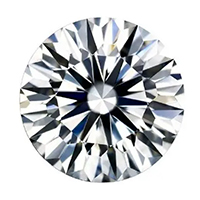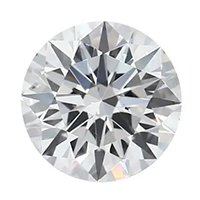7 Minute Read
Diamond Cut Guide
One of the most striking qualities that a diamond has is its sparkle, and it’s often the first thing people notice. A beautiful sparkling ring that returns light and glimmers in just the right way can really set a piece of jewellery apart from all others. But how do you get that perfect diamond sparkle? What can you expect to pay for it? And how does cut differ from shape?
In this guide you’ll find everything you need to know about choosing the best value and most elegant diamond cut, to achieve brilliant sparkle within your budget. Included are our own hints and tips, explanations and guides for choosing the ideal stone.
Diamond Anatomy Glossary
Here's a quick glossary of terms used in this guide:
- Crown – Top part of a diamond extending from girdle to table
- Culet – The facet at the tip of the stone. An ideal culet is not visible to an untrained eye
- Depth – Height of the stone from the culet to table. A lower depth % can cause a diamond to appear larger, due to increased width, however, a depth % that is too low can make a diamond appear dark
- Diameter or Width – The measurements from one girdle edge to the other
- Dispersion – As light exits the diamond, white light is separated into multiple colours
- Girdle – The circumference of the diamond defined by the intersection of the crown and pavilion
- Pavilion – The bottom part of the diamond, from the girdle to the culet
- Reflection – When light enters the surface of the diamond and a portion is reflected back out of the top
- Refraction – When light travels into the centre of the diamond and bounces of the inside walls
- Table – The largest face of the stone. If the table % is too large, light won’t reflect off the diamond’s crown, angles and facets. If the table % is too low, light will be trapped inside the diamond instead of being refracted. The ideal table % depends on the diamond’s shape.
What Is Diamond Cut?
The cut of a diamond refers to the facets, symmetry, dimensions and reflective qualities of a diamond. A well-cut diamond will appear very sparkly and will refract light very well, whereas a poorly cut diamond may appear dull or lifeless.
Small factors in the way a diamond is cut, such as its diameter compared to its depth, will influence the final sparkle of the stone because they will affect how light passes through it and is reflected back out. A well-cut diamond may even appear larger and more brilliant than it really is, because it is brighter and more vibrant.
ⓘ Need to know:
Diamond cut and diamond shape are often interchanged in conversation but they are separate. The cut of a diamond is an assessment of how well it refracts light (sparkle), whereas a diamond’s shape refers to its actual outline, such as oval or pear, or round brilliant diamonds.

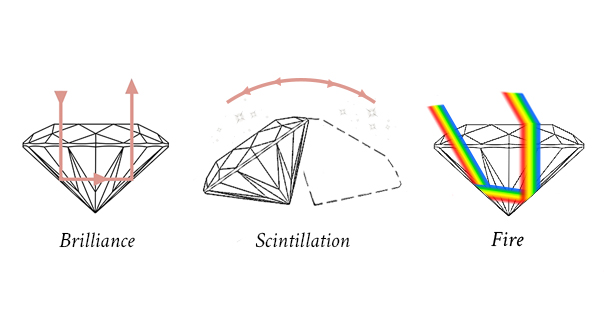
How Important Is Diamond Cut?
The way a diamond is cut will directly impact its final appearance. The cut will affect –
- Brilliance – the way the gem reflects white light
- Fire – the flashes of colour seen through all aspects of the gem
- Scintillation – areas of light and dark which reflect light when the diamond is moved
The cut of a diamond is important to consider if you want to make the most of these features. Whilst it might be tempting to simply opt for the biggest stone, it’s often the stone which sparkles and glimmers the most that attracts the eye and impresses.
Dull vs Dark vs Dazzling
A diamond’s cut proportions are ratios between its size, angle and shape of each diamond facet. The relationship between these factors will determine the final appearance of the diamond.
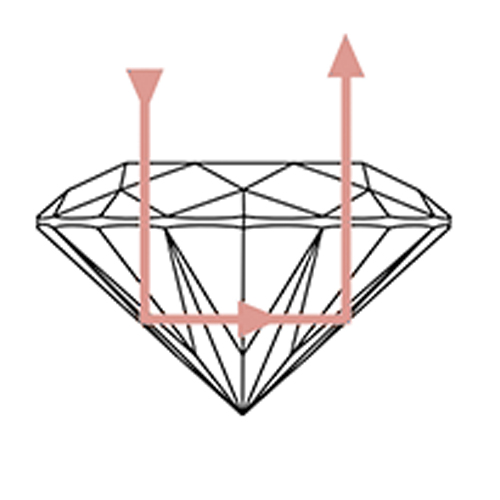
Ideal
Diamonds cut to the ideal proportions have the greatest sparkle. As light enters these diamonds it is reflected internally, from one facet to another, and dispersed evenly. This perfectly balances the light and fire giving the diamond its shine.
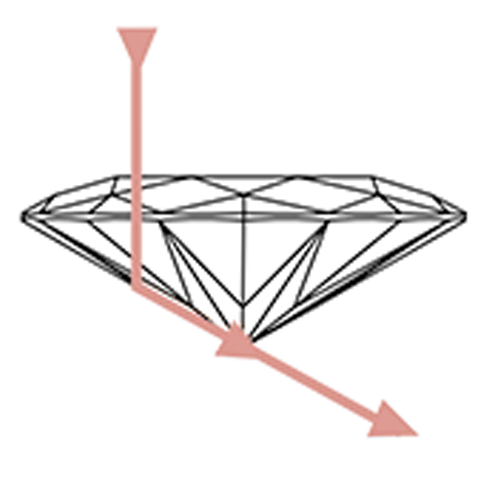
Shallow Cut
A diamond cut that is too shallow will cause light to travel through the stone and exit through the sides, rather than reflecting through the table and back into your eyes. Although a shallow cut diamond might initially appear larger, because it allows light to escape through the size and bottom it will appear less bright and sparkly.
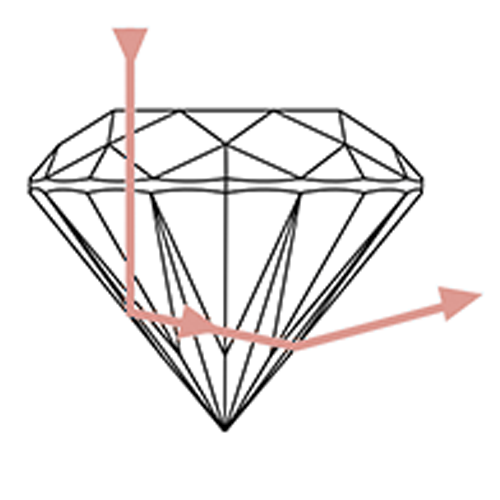
Deep Cut
A diamond cut that is too deep causes light to hit the pavilion at a sharper angle, forcing it to pass through the bottom of a diamond. This results in a diamond that appears both dull and small in appearance.
Diamond Cut Scale
Diamonds are cut by highly skilled craftsmen, who will often train for over 10 years before even attempting to cut a one-carat gem. By following specific requirements, the sparkle of a diamond can be maximised by the way the diamond is cut.
The GIA (along with other gem labs) assesses the cut grade of diamonds by considering the finished stone’s proportions, polish, symmetry, depth and finish. The final gem is awarded one of the following values which you can find in a diamond certificate:
Example image |
|
|
|
|
|
Grade | Excellent | Very good | Good | Fair | Poor |
Description | Maximum brilliance, fire and scintillation with very little light lost in refraction. Represents top 3% of diamond cut quality. | Superior levels of brilliance, fire and scintillation, most light is refracted. Represents top 15% of diamond cut quality. | Not as much brilliance, fire and scintillation but still an attractive gem. Represents top 25% of diamond cut quality. | Allows significant amounts of light to exit before refraction, quality cut but not superior. Will not sparkle in the same way. | Diamond appears dull or lifeless, obvious lack of sparkle even to an untrained eye. |
Top Tip: Keep in mind that the above grading system is only for round, brilliant cut diamonds. Fancy shaped diamonds (such as pear, oval, square etc) have a cut grade based on their unique proportions.
Frequently Asked Questions
Here's some most frequently asked questions to help you choose the right diamond cut.
As you may know, choosing the best diamond is an act of balancing the 4Cs – cut, colour, clarity and carat. The cut of a diamond is one of the most important of these factors because it will have the greatest influence on the stone’s final brilliance. Remember that even a diamond with a perfect clarity or carat grade can look dull and lifeless if the stone is cut too shallow or deep.
A well cut diamond will maximise the light that hits each of its pavilions. Instead of being forced through the sides or bottom of the diamond, this light is refracted back through the crown and table, into the eyes of the person looking at the diamond.
This makes it appear more brilliant and sparkly. If possible, aim for a diamond that is graded ‘Excellent’ for cut as even if this has a lower carat weight or clarity value, it will appear the most vibrant and attractive. Better to choose a smaller well cut diamond than a larger poorly cut diamond, if your aim is to impress.
When you are choosing your diamond, take note of how its facets reflect light. Move it around to assess the sparkle and if possible, hold it under a lamp to assess its full potential to reflect light. Watch out for any dark spots within the piece. Any jeweller will assist you in advising how best to view your diamond - a good tip is to hold the diamond up-right above a sheet of white paper to see how light passes through the stone clearly.
If you’re on a budget, spending more on getting a higher quality of cut, even if that comes as a compromise to the carat weight, colour or clarity you can afford, can be a good call. The cut is one of the major factors that will affect the gem’s beauty, so spending your budget on a quality cut grade will ensure a stunning final purchase.
Ultimately it is your choice as a buyer to decide which of the 4C’s is most important to you and your recipient. The best advice we can provide you is to work closely with your jeweller and go and see the stone for yourself. Any jeweller (including ourselves) will be happy to help you understand the differences and provide comparison stones so that you can see in-store for yourself. You can speak to a member of the Johnsons Jewellers bridal team here: Contact us.
Still need help?
If you need any further assistance and guidance with diamond clarity, our jewellery experts are here to help! Visit us in store or call us to arrange an appointment so we can provide the guidance you need. You can also send a message via zendesk in the bottom right of your screen.
Libby Johnson
Director, Johnsons Jewellers




